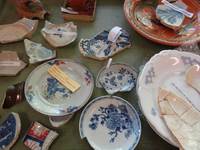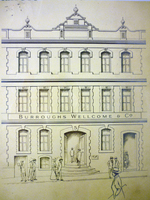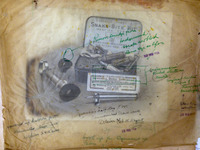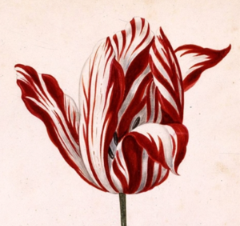Items
Site
The Medicine Chest
Is Part Of is exactly
School of Economics
-

The Mother of all Firewalls
'The Mother of all Firewalls' (2012), is a sculptural piece by Kim Gurney made from beeswax, gold glitter, bitumen, repurposed tiles, rabbit skin and glue, which seems to depict an EEG graph in its format but in reality references a graph plotted by Google Insights after Gurney inputted a range of new words that emerged from the ‘Eurogeddon’ of 2012, showing their incidence in news reports pertaining to this financial crisis between 2008 and 2012. -

Things archaeological insiders look at
A variety of pottery shards of Asian porcelain, European earthenware and British stoneware in a drawer in the Department of Archaeology, UCT. -

BWC Cape Town premises
"When Burroughs died of pneumonia in 1895, Wellcome became BWC’s sole owner, and the next 20 years (until the outbreak of World War I) constituted a period of massive expansion for the company (Bailey 2008: online). In 1898, the first overseas branch opened in Sydney and was followed by seven more branches – in New York, Montreal, Buenos Aires, Cape Town, Milan, Shanghai and Bombay – by 1912. The Cape Town branch opened in 1902, seven years after Wellcome made his first visit to the city in 1895" (Liebenberg 2021: 49 - 51). -

BWC Cape Town premises (drawing)
Line drawing of the Burroughs Wellcome & Co. office, Cape Town, South Africa. -

Corrections
Examples of Wellcome's design changes annotated on tracing paper. 1914–1938. WF/M/I/PR/O01/3, 4, 9, 8. Wellcome Collection. -

The broken tulip
"During the period known as tulipmania which transpired in the Netherlands during the 17th century, contract prices for bulbs of the recently introduced tulip reached extraordinarily high levels and then suddenly collapsed. Tulips that displayed a break in their colour reached prices far higher than those that didn’t. It wasn’t until 1920, after the invention of the electron microscope, that scientists discovered that the cause for this symphony of colour was a virus that spread from tulip to tulip by Myzus persicae, the peach potato aphid. Michael Pollan in The Botany of Desire, explains this phenomenon: “The colour of a tulip consists of two pigments working in concert — a base colour that is always yellow or white and a second, laid-on colour called an anthocyanin; the mix of these two hues determining the unitary colour we see. The virus works by partially and irregularly suppressing the anthocyanin, thereby allowing a portion of the underlying colour to show through — creating the magic of the broken tulip. A fact that, as soon as it was discovered, doomed the beauty it had made possible" (Pollan 2003: 97 in Liebenberg 2011: 92). -

Semper Augustus Tulip
Photo of Semper Augustus watercolour, captured whilst perusing the Pera Museum, Istanbul, 2013


